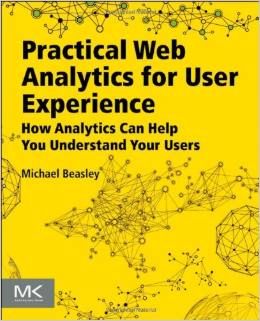| Practical Web Analytics for User Experience |
|
Author: Michael Beasley ISBN: 9780124046191 Rating: 4 Explores "How Analytics Can Help You Understand Your Users". Does it provide useful insights - and for whom? Michael Beasley is an experienced user experience designer and expects his reader to have a background in usability testing and contextual enquiry. Because of this he doesn't go into any discussion of "user experience", simply stating in the introductory chapter that: For the purpose of this book, user experience is meant to describe the practice of utilizing user research and design techniques - including usability testing, user personas, and user-centered design - to make items usable, useful and delightful. In fact his working definition is narrow than this since the only items under discussion are web pages. As well as giving an overview of what web analytics is, the introduction also explains how it complements the user experience methods you are assumed to be using.
Beyond the introduction, the book has three parts. Part 1 Introduction to Web Analytics, has three chapters. The first is a very general discussion of the Web Analytics approach and how you should get to know your website and then formulate questions, gather data, transform and analyze it. The Key Takeaways at the end of the chapter provide a good summary of what is covered. The next chapter How Web Analytics Works quickly gets to the practical topic of how Google Analytics works and how to start using it. The final chapter of this part is on Goals. It starts by pointing out the importance of having goals and measuring conversion rates, i.e.e the proportion of website visitors that complete a desired action specified as the goal. It goes on to explore the goal reports available in Google Analytics and devotes the rest of the chapter to choosing the goals you should measure both for e-commerce websites and also for those with more diverse business goals. Part 2 Learning about Users through Web Analytics consists of seven chapters. The first of them is a thorough overview of website visitor analytics using the Audience menu in Google Analytics. Next comes a chapter on Traffic Analytics, looking at how visitors arrive at a website. The emphasis here is on search query analysis and Beasley shows how to construct a spreadsheet to discover which keywords brought visitors to your site. In the following chapter Beasley turns his attention to how users interact with the pages of a website and explores the Content menu in Google Analytics including In-Page Analytics. In the chapter on Click-Path Analysis Beasley shows how you can explore the way users move from one page to another. While a couple of other click-stream analysis tools are mentioned, as usual he concentrates on those provide as part of Google Analytics - the Navigation Summary and Visitor Flow reports. Segmentation, i.e. filtering data to identify users who fit specific profiles is the next technique to be introduced using examples that illustrate both how and why to do it. Following on from this the chapter "Pairing Analytics Data with UX Methods" looks at using web analytics in combination with personas, usability testing, Usability Inspection and design and design objectives. The final chapter in this part is on "Measuring the Effects of Change".
Part 3 Advanced Topics starts with a "Measuring Behavior within Pages" which return to consideration of Google Analytics In-Page analytics.and the general idea of tools that measure where people click on a page - which can be done by adding tracking code. Additional tracking code is also required in the next chapter on A/B Testing, something for which Google analytics has an integrated tool - its Content Experiments feature. Analytics Profiles, which allows you to limit the data you obtain from Google Analytics is the subject of a very short chapter and in the penultimate chapter the topic is on reporting and advocates including web analytics data in regular communications with stakeholders. In the final three pages Beasley looks at "Web Analytics in the Near Future" and covers mobile application analytics and cross device measurement. It also looks forward to better measurement of on-page behavior. While he concludes that the area of web analytics will continue to change, he is confident that Google will remain as a dominant force. This book is targeted at UX practitioners but, given its almost exclusive focus on Google Analytics, which is a free tool, it will also be useful to website owners and designers who have to attend to alll aspects of their site, including user experience, without having a UX professional to call on.
|
|||
| Last Updated ( Monday, 01 December 2014 ) |

